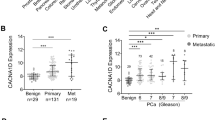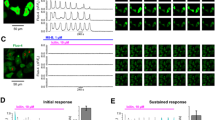Abstract
The transient receptor potential channel, subfamily V, member 6 (TRPV6), is strongly expressed in advanced prostate cancer and significantly correlates with the Gleason >7 grading, being undetectable in healthy and benign prostate tissues. However, the role of TRPV6 as a highly Ca2+-selective channel in prostate carcinogenesis remains poorly understood. Here, we report that TRPV6 is directly involved in the control of prostate cancer cell (LNCaP cell line) proliferation by decreasing: (i) proliferation rate; (ii) cell accumulation in the S-phase of cell cycle and (iii) proliferating cell nuclear antigen (PCNA) expression. We demonstrate that the Ca2+ uptake into LNCaP cells is mediated by TRPV6, with the subsequent downstream activation of the nuclear factor of activated T-cell transcription factor (NFAT). TRPV6-mediated Ca2+ entry is also involved in apoptosis resistance of LNCaP cells. Our results suggest that TRPV6 expression in LNCaP cells is regulated by androgen receptor, however, in a ligand-independent manner. We conclude that the upregulation of TRPV6 Ca2+ channel in prostate cancer cells may represent a mechanism for maintaining a higher proliferation rate, increasing cell survival and apoptosis resistance as well.
This is a preview of subscription content, access via your institution
Access options
Subscribe to this journal
Receive 50 print issues and online access
$259.00 per year
only $5.18 per issue
Buy this article
- Purchase on Springer Link
- Instant access to full article PDF
Prices may be subject to local taxes which are calculated during checkout


Similar content being viewed by others
References
Bidaux G, Roudbaraki M, Merle C, Crepin A, Delcourt P, Slomianny C et al. (2005). Evidence for specific TRPM8 expression in human prostate secretory epithelial cells: functional androgen receptor requirement. Endocr Relat Cancer 12: 367–382.
Bodding M, Fecher-Trost C, Flockerzi V . (2003). Store-operated Ca2+ current and TRPV6 channels in lymph node prostate cancer cells. J Biol Chem 278: 50872–50879.
Bodding M, Flockerzi V . (2004). Ca2+ dependence of the Ca2+-selective TRPV6 channel. J Biol Chem 279: 36546–36552.
Burnstein KL . (2005). Regulation of androgen receptor levels: implications for prostate cancer progression and therapy. J Cell Biochem 95: 657–669.
Cooperberg MR, Moul JW, Carroll PR . (2005). The changing face of prostate cancer. J Clin Oncol 23: 8146–8151.
Fixemer T, Wissenbach U, Flockerzi V, Bonkhoff H . (2003). Expression of the Ca2+-selective cation channel TRPV6 in human prostate cancer: a novel prognostic marker for tumor progression. Oncogene 22: 7858–7861.
Korkmaz KS, Elbi C, Korkmaz CG, Loda, M, Hager GL, Saatcioglu F . (2002). Molecular cloning and characterization of STAMP1, a highly prostate-specific six transmembrane protein that is overexpressed in prostate cancer. J Biol Chem 277: 36689–36696.
Legrand G, Humez S, Slomianny C, Dewailly E, Vanden Abeele F, Mariot P et al. (2001). Ca2+ pools and cell growth. Evidence for sarcoendoplasmic Ca2+-ATPases 2B involvement in human prostate cancer cell growth control. J Biol Chem 276: 47608–47614.
Lipskaia L, Lompre AM . (2004). Alteration in temporal kinetics of Ca2+ signaling and control of growth and proliferation. Biol Cell 96: 55–68.
Montell C, Birnbaumer L, Flockerzi V . (2002). The TRP channels, a remarkably functional family. Cell 108: 595–598.
Peng JB, Zhuang L, Berger UV, Adam RM, Williams BJ, Brown EM et al. (2001). CaT1 expression correlates with tumor grade in prostate cancer. Biochem Biophys Res Commun 282: 729–734.
Prevarskaya N, Skryma R, Shuba Y . (2004). Ca2+ homeostasis in apoptotic resistance of prostate cancer cells. Biochem Biophys Res Commun 322: 1326–1335.
Schindl R, Kahr H, Graz I, Groschner K, Romanin C . (2002). Store depletion-activated CaT1 currents in rat basophilic leukemia mast cells are inhibited by 2-aminoethoxydiphenyl borate. Evidence for a regulatory component that controls activation of both CaT1 and CRAC (Ca(2+) release-activated Ca(2+) channel) channels. J Biol Chem 277: 26950–26958.
Schwarz EC, Wissenbach U, Niemeyer BA, Strauss B, Philipp SE, Flockerzi V et al. (2006). TRPV6 potentiates calcium-dependent cell proliferation. Cell Calcium 39: 163–173.
Skryma R, Mariot P, Bourhis XL, Coppenolle FV, Shuba Y, Vanden Abeele F et al. (2000). Store depletion and store-operated Ca2+ current in human prostate cancer LNCaP cells: involvement in apoptosis. J Physiol 527(Part 1): 71–83.
Thebault S, Flourakis M, Vanoverberghe K, Vandermoere F, Roudbaraki M, Lehen'kyi V et al. (2006). Differential role of transient receptor potential channels in Ca2+ entry and proliferation of prostate cancer epithelial cells. Cancer Res 66: 2038–2047.
Vanden Abeele F, Lemonnier L, Thebault S, Lepage G, Parys JB, Shuba Y et al. (2004). Two types of store-operated Ca2+ channels with different activation modes and molecular origin in LNCaP human prostate cancer epithelial cells. J Biol Chem 279: 30326–30337.
Vanden Abeele F, Roudbaraki M, Shuba Y, Skryma R, Prevarskaya N . (2003). Store-operated Ca2+ current in prostate cancer epithelial cells. Role of endogenous Ca2+ transporter type 1. J Biol Chem 278: 15381–15389.
Vanden Abeele F, Skryma R, Shuba Y, Van Coppenolle F, Slomianny C, Roudbaraki M et al. (2002). Bcl-2-dependent modulation of Ca(2+) homeostasis and store-operated channels in prostate cancer cells. Cancer Cell 1: 169–179.
Vanoverberghe K, Vanden Abeele F, Mariot P, Lepage G, Roudbaraki M, Bonnal JL et al. (2004). Ca2+ homeostasis and apoptotic resistance of neuroendocrine-differentiated prostate cancer cells. Cell Death Differ 11: 321–330.
Wang LG, Liu XM, Kreis W, Budman DR . (1999). Phosphorylation/dephosphorylation of androgen receptor as a determinant of androgen agonistic or antagonistic activity. Biochem Biophys Res Commun 259: 21–28.
Wang TT, Tavera-Mendoza LE, Laperriere D, Libby E, MacLeod NB, Nagai Y et al. (2005). Large-scale in silico and microarray-based identification of direct 1,25-dihydroxyvitamin D3 target genes. Mol Endocrinol 19: 2685–2695.
Wissenbach U, Niemeyer B, Himmerkus N, Fixemer T, Bonkhoff H, Flockerzi V . (2004). TRPV6 and prostate cancer: cancer growth beyond the prostate correlates with increased TRPV6 Ca2+ channel expression. Biochem Biophys Res Commun 322: 1359–1363.
Xiao F, Mirwald A, Papaioannou M, Baniahmad A, Klug J . (2005). Secretoglobin 2A1 is under selective androgen control mediated by a peculiar binding site for Sp family transcription factors. Mol Endocrinol 19: 2964–2978.
Acknowledgements
This work was supported by grants from Institut National de la Santé et de la Recherche Médicale, Ministère de l'Education Nationale, Ligue National Contre le Cancer and Institut National du Cancer. V'yacheslav Lehen'kyi was supported by a grant from Institut National du Cancer, Ministère de l'Education Nationale and Regione Nord Pas-de Calais.
Author information
Authors and Affiliations
Corresponding author
Rights and permissions
About this article
Cite this article
Lehen'Kyi, V., Flourakis, M., Skryma, R. et al. TRPV6 channel controls prostate cancer cell proliferation via Ca2+/NFAT-dependent pathways. Oncogene 26, 7380–7385 (2007). https://doi.org/10.1038/sj.onc.1210545
Received:
Revised:
Accepted:
Published:
Issue Date:
DOI: https://doi.org/10.1038/sj.onc.1210545
Keywords
This article is cited by
-
Mutant p53 elicits context-dependent pro-tumorigenic phenotypes
Oncogene (2022)
-
Auto-inhibitory intramolecular S5/S6 interaction in the TRPV6 channel regulates breast cancer cell migration and invasion
Communications Biology (2021)
-
Light-controlled calcium signalling in prostate cancer and benign prostatic hyperplasia
Future Journal of Pharmaceutical Sciences (2020)
-
Protein kinase CK2 impact on intracellular calcium homeostasis in prostate cancer
Molecular and Cellular Biochemistry (2020)
-
Altered expression and functional role of ion channels in leukemia: bench to bedside
Clinical and Translational Oncology (2020)



